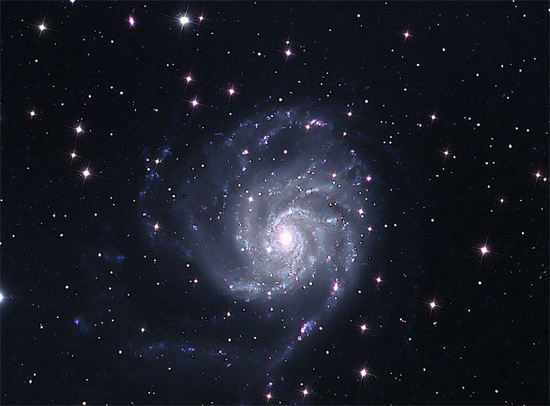 M101 (NGC 5457), the Pinwheel Galaxy. Image credit: Donald E. Scott
M101 (NGC 5457), the Pinwheel Galaxy. Image credit: Donald E. Scott
Sep 23, 2011
A new supernova explosion highlights the same old gravity problems.
On August 24, 2011 astronomers from the Palomar Transient Factory discovered the first type 1A supernova seen in decades. Type 1A class stellar explosions (or, implosions) are important to how astronomers view the Universe for two reasons: their light-curves, or graphs of their intensity over time, are considered to be so predictable that they can be used as cosmic measuring rods, with a theoretical accuracy of 1000 mega-parsecs (3.26 billion light years), and those measurement at such great distances can be useful in determining the so-called “expansion rate” of the Universe.
It was through the use of such data that a theory of “dark energy” was first considered. By taking the “accurate” redshift readings of type 1A supernovae at cosmological distances, it was discovered that the velocity of expansion was accelerating. Since all the matter in the Universe (along with all of another dark concept, “dark matter”) cannot provide enough inertia to cause that impetus, dark energy was created in order to make up for the missing 70%. As with dark matter, dark energy is undetectable by any instrument.
Many previous Picture of the Day articles have pointed out that stars are not simplistic balls of gravitationally compressed hot gas, they are composed of plasma. Plasma is ionized, meaning that one or more electrons have been stripped from the atoms in its substance, so it is electrically charged. Plasma does not behave like a pressurized gas, it behaves according to the tenets of plasma physics.
Laboratory experiments confirm that electricity flowing through plasma forms regions separated by thin walls of opposite charge called double layers. This is the “charge separation” so often mentioned in these pages. Could charge separation be the foundation for the electrical explosions known as supernova?
Electric Universe theory agrees with conventional astrophysics in that a supernova can be referred to as an “exploding star.” However, in an electrically charged plasma star, that explosion is due to the breakdown of double layers. The power that fuels the stars comes from external currents of electric charge flowing through vast circuits in space. Rather than “core rebound” or “white dwarf accretion,” supernovae are the result of a stellar “circuit breaker” where the stored electromagnetic energy in the circuit is suddenly focused at one point.
When a star’s double layer explodes, the electrical energy from its connection to a vast stellar circuit flows into the explosion. The resulting supernova radiation is emitted across the entire electromagnetic spectrum from radio to gamma rays. The unexplained “standard candle” attribute of type 1a supernovae has, at last, a plausible explanation in terms of a star’s electrical environment rather than an implausible sudden collapse of a star.
Since stars can be thought of as the focus for immense energy from the galaxies in which they live, their activity cannot be based on whether they possess a certain mass, or a particular elemental constitution. Rather, they are not internally powered objects at all; they are bodies formed electromagnetically where gigantic plasma filaments have squeezed matter in what is called a “z-pinch.” That is how stars are born and that is where the seeds of supernovae are planted.
Stephen Smith












